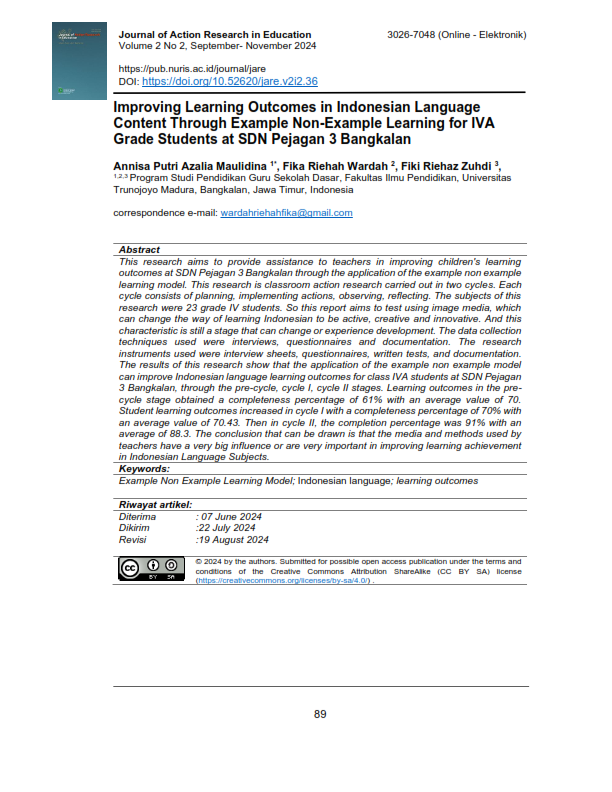Improving Learning Outcomes in Indonesian Language Content Through Example Non-Example Learning for IVA Grade Students at SDN Pejagan 3 Bangkalan
DOI:
https://doi.org/10.52620/jare.v2i2.36Keywords:
Example Non Example Learning Model, Indonesian language, Learning outcomesAbstract
This research aims to provide assistance to teachers in improving children's learning outcomes at SDN Pejagan 3 Bangkalan through the application of the example non example learning model. This research is classroom action research carried out in two cycles. Each cycle consists of planning, implementing actions, observing, reflecting. The subjects of this research were 23 grade IV students. So this report aims to test using image media, which can change the way of learning Indonesian to be active, creative and innovative. And this characteristic is still a stage that can change or experience development. The data collection techniques used were interviews, questionnaires and documentation. The research instruments used were interview sheets, questionnaires, written tests, and documentation. The results of this research show that the application of the example non example model can improve Indonesian language learning outcomes for class IVA students at SDN Pejagan 3 Bangkalan, through the pre-cycle, cycle I, cycle II stages. Learning outcomes in the pre-cycle stage obtained a completeness percentage of 61% with an average value of 70. Student learning outcomes increased in cycle I with a completeness percentage of 70% with an average value of 70.43. Then in cycle II, the completion percentage was 91% with an average of 88.3. The conclusion that can be drawn is that the media and methods used by teachers have a very big influence or are very important in improving learning achievement in Indonesian Language Subjects.
References
Asriani. Arsal, N. & Fitriani. Penerapan Model Pembelajaran Number Head Together untuk Meningkatkan Hasil Belajar IPA Siswa Kelas IV. Global Journal Teaching Professional. 3(1). 86-95.
Lestari, A. (2022). Model Pembelajaran Tipe Numbered Head Together untuk Meningkatkan Kemampuan Matematika. Lombok: Pusat Pengembangan Pendidikan dan Penelitian Indonesia.
Lestari, R. & Saputra, W. (2020). Penerapan Model Numbered Heads Together (NHT) untuk Meningkatkan Hasil Belajar IPS Peserta Didik Kelas VI SD. Jurnal Muara Pendidikan. 5(2). 764-770.
Novakhta, V. dkk. (2023). Penerapan Model Project Based Learning Dengan Media
Konkret untuk Meningkatkan Hasil Belajar Matematika Kelas V E di SDN Polisi 1 Kota Bogor. Didaktik: Jurnal Ilmiah PGSD FKIP Universitas Mandiri, 9(2). 1070-1079.
Prayitno. dkk. (2022). Strategi, Pendekatan & Model Cooperative Learning dalam Pembelajaran Matematika. Sukabumi: CV Jejak (Jejak Publisher).
Suhelayanti. dkk. (2023). Pembelajaran Ilmu Pengetahuan Alam dan Sosial (IPAS). ¬¬¬___ : Yayasan Kita Menulis.
Suhono. (2022). Penggunaan Model Pembelajaran Make a Match untuk Meningkatkan Motivasi dan Hasil Belajar Sistem Reproduksi Manusia. Surakarta: UNISRI Press.
Taliak, J. (2020). Teori dan Model Pembelajaran. Indramayu: Penerbit Adab.
Utami, O. Oktaviani, I. & Ardianti, S. (2024). Peningkatan Hasil Belajar IPAS Kelas IV SD Melalui Model Pembelajaran Numbered Heads Together dengan Media Kipas. Jurnal Basicedu, 8(1). 739-746.
Zuriati, E. & Astimar, N. (2020). Peningkatan Hasil Belajar pada Pembelajaran Tematik Terpadu Menggunakan Model Problem Based Learning Di Kelas IV SD (Studi Literatur). Jurnal Pendidikan Tambusai, 4(3). 2071-2082.




